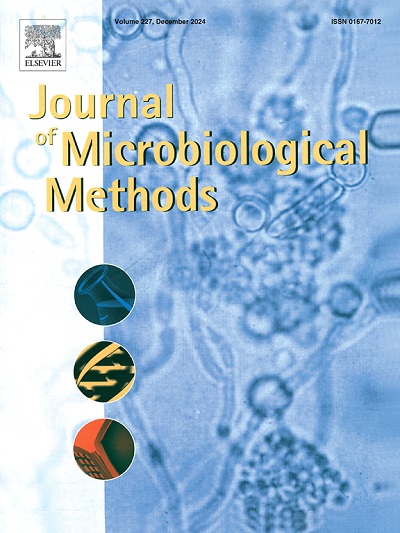双抗体夹心ELISA检测PEDV N蛋白的建立
IF 1.9
4区 生物学
Q4 BIOCHEMICAL RESEARCH METHODS
引用次数: 0
摘要
猪流行性腹泻病毒(PEDV)具有高传染性和致死率,严重影响仔猪健康,给养猪业造成重大经济损失。本研究以HEK-293i细胞表达的重组N蛋白为免疫原,成功制备了两种抗pedv N蛋白单克隆抗体4F2和2G4。功能分析显示,4F2和2G4均适用于免疫荧光试验(IFA)和Western blot。表位筛选表明,这些单克隆抗体识别不同的表位:4F2结合了n端保守的线性表位,而2G4靶向了c端结构域的线性表位“SGKNTPKKNKSRATSKE”,该表位在不同病毒株中高度保守。利用获得的抗体,建立了用于PEDV检测的双抗体夹心定量ELISA (DAS-ELISA)。该方法灵敏度高,能检测到低至0.05 ng/mL的重组N蛋白和102.59 TCID50(50%组织培养感染剂量)的病毒。它还表现出特异性,与PRV、PRRSV、ASFV或PCV2无交叉反应。该酶联免疫吸附试验能够方便地检测仔猪粪便中的PEDV,有助于根除PEDV。本文章由计算机程序翻译,如有差异,请以英文原文为准。
Development of double-antibody sandwich ELISA for detecting PEDV N protein
Porcine epidemic diarrhea virus (PEDV) severely impacts piglets with high contagion and lethality, leading to significant economic losses in the swine industry. In this study, two anti-PEDV N protein monoclonal antibodies (4F2 and 2G4) were successfully prepared using the HEK-293i cell-expressed recombinant N protein as an immunogen. Functional analysis revealed that both 4F2 and 2G4 were applicable to immunofluorescence assay (IFA) and Western blot. Epitope screening showed that these mAbs recognized distinct epitopes: 4F2 bound a conserved linear epitope in the N-terminal domain, while 2G4 targeted the linear epitope “SGKNTPKKNKSRATSKE” in the C-terminal domain, which is highly conserved across different virus strains. Using the obtained antibodies, we developed a double-antibody sandwich quantitative ELISA (DAS-ELISA) for PEDV detection. The assay demonstrated remarkable sensitivity, capable of detecting the recombinant N protein at a concentration as low as 0.05 ng/mL and the virus at a titer of 102.59 TCID50 (50 % tissue culture infectious dose). It also exhibited specificity, with no cross-reactivity to PRV, PRRSV, ASFV, or PCV2. This ELISA should enable convenient PEDV detection in piglet excreta and aid in PEDV eradication efforts.
求助全文
通过发布文献求助,成功后即可免费获取论文全文。
去求助
来源期刊

Journal of microbiological methods
生物-生化研究方法
CiteScore
4.30
自引率
4.50%
发文量
151
审稿时长
29 days
期刊介绍:
The Journal of Microbiological Methods publishes scholarly and original articles, notes and review articles. These articles must include novel and/or state-of-the-art methods, or significant improvements to existing methods. Novel and innovative applications of current methods that are validated and useful will also be published. JMM strives for scholarship, innovation and excellence. This demands scientific rigour, the best available methods and technologies, correctly replicated experiments/tests, the inclusion of proper controls, calibrations, and the correct statistical analysis. The presentation of the data must support the interpretation of the method/approach.
All aspects of microbiology are covered, except virology. These include agricultural microbiology, applied and environmental microbiology, bioassays, bioinformatics, biotechnology, biochemical microbiology, clinical microbiology, diagnostics, food monitoring and quality control microbiology, microbial genetics and genomics, geomicrobiology, microbiome methods regardless of habitat, high through-put sequencing methods and analysis, microbial pathogenesis and host responses, metabolomics, metagenomics, metaproteomics, microbial ecology and diversity, microbial physiology, microbial ultra-structure, microscopic and imaging methods, molecular microbiology, mycology, novel mathematical microbiology and modelling, parasitology, plant-microbe interactions, protein markers/profiles, proteomics, pyrosequencing, public health microbiology, radioisotopes applied to microbiology, robotics applied to microbiological methods,rumen microbiology, microbiological methods for space missions and extreme environments, sampling methods and samplers, soil and sediment microbiology, transcriptomics, veterinary microbiology, sero-diagnostics and typing/identification.
 求助内容:
求助内容: 应助结果提醒方式:
应助结果提醒方式:


